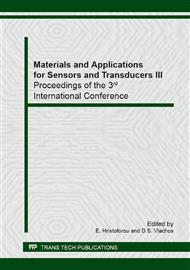p.59
p.63
p.67
p.71
p.75
p.79
p.83
p.87
p.91
Functionalized Carbon Nanotubes-Based Gas Sensors for Pollutants Detection: Investigation on the Use of a Double Transduction Mode
Abstract:
With an objective to fabricate Carbon nanotubes (CNTs) based sensors, the solution route is investigated. The dispersion routes are chosen here to avoid the CNTs to form bundles which can reduce their surface area. The results show that SWNTs-based gas sensors made by the surfactant method is possible if the annealing temperature is correctly chosen. The use of a surfactant allows preparing sensing layers which present responses to NO2 exposure in the 50-200 ppb Range. In a second procedure the CNTs are noncovalently functionalized and used as sensing material for BTX (Benzene, Toluene and Xylenes) detection. The noncovalent functionalisation occurs through p-p stacking between the SWNTs framework and the highly delocalized π-system of the macrocycle which are phthalocyanines and porphyrines derivatives. The SWNTs materials are characterized by standard techniques (UV-Vis spectroscopy, TGA, TEM, Raman analysis). For BTX detection, we used a double transduction mode: IDEs (Interdigitated electrodes) and QCM (Quartz Crystal Microbalance) in order to get insight into the sensing mechanism.
Info:
Periodical:
Pages:
75-78
Citation:
Online since:
April 2014
Keywords:
Price:
Сopyright:
© 2014 Trans Tech Publications Ltd. All Rights Reserved
Share:
Citation:


